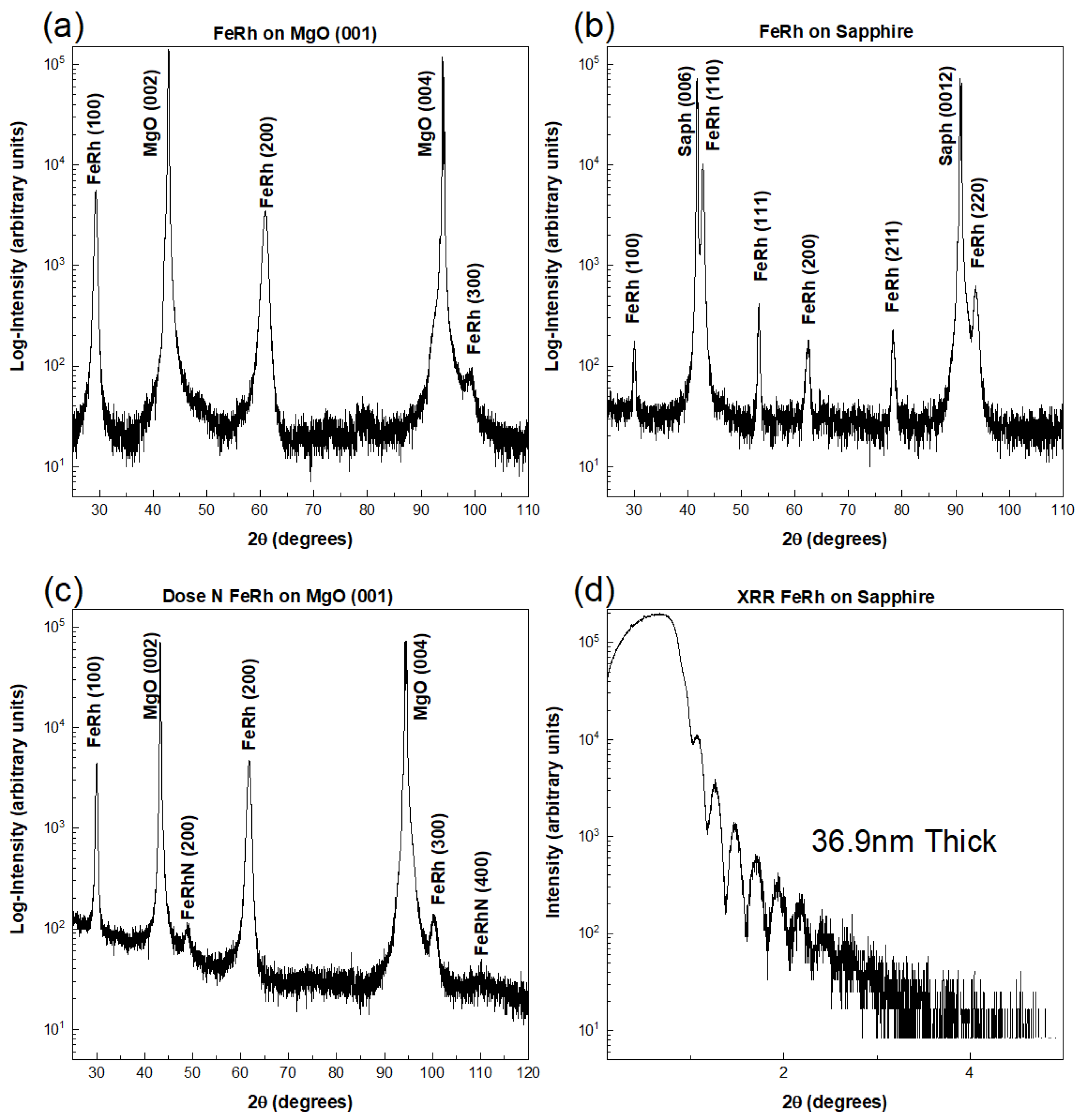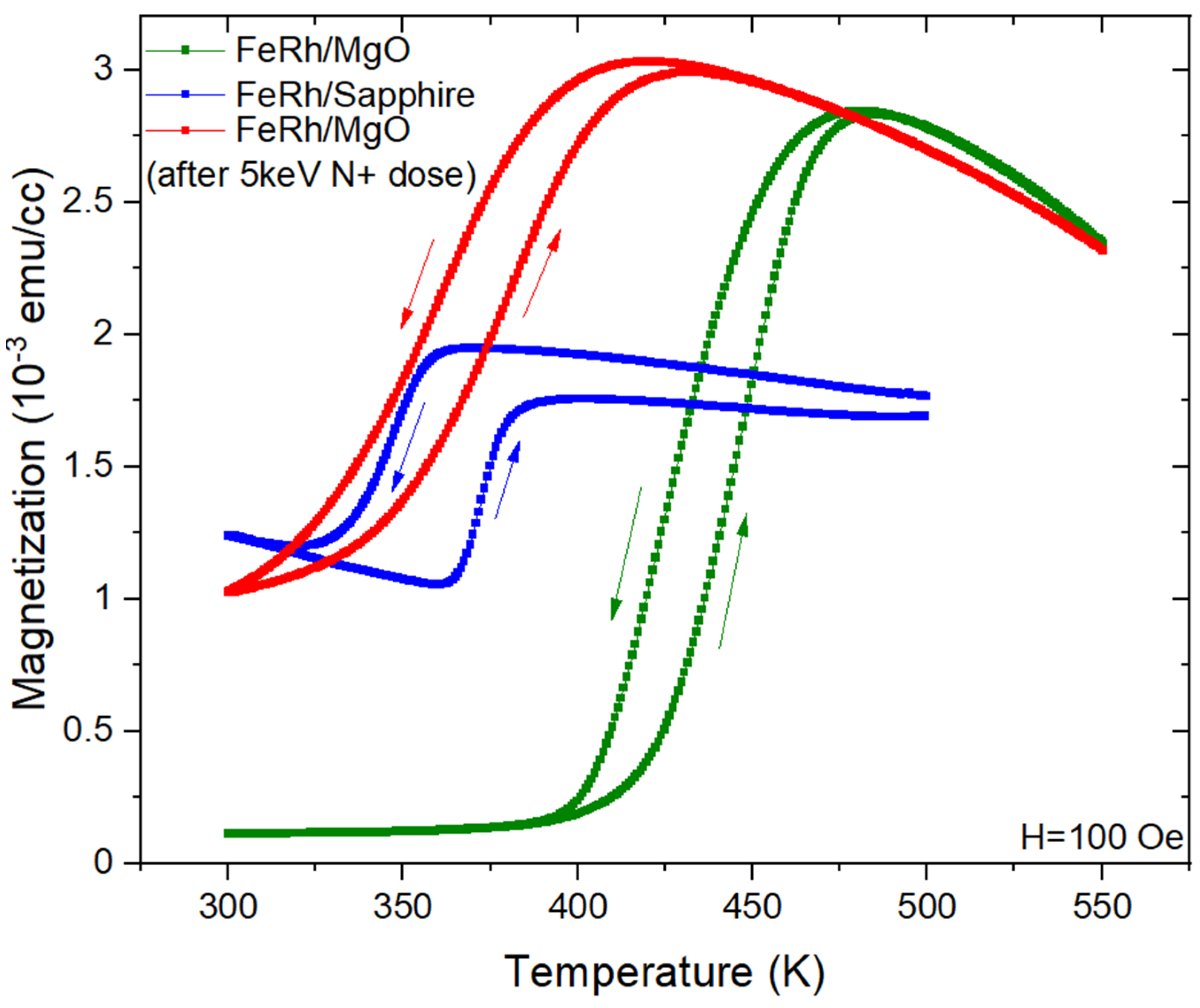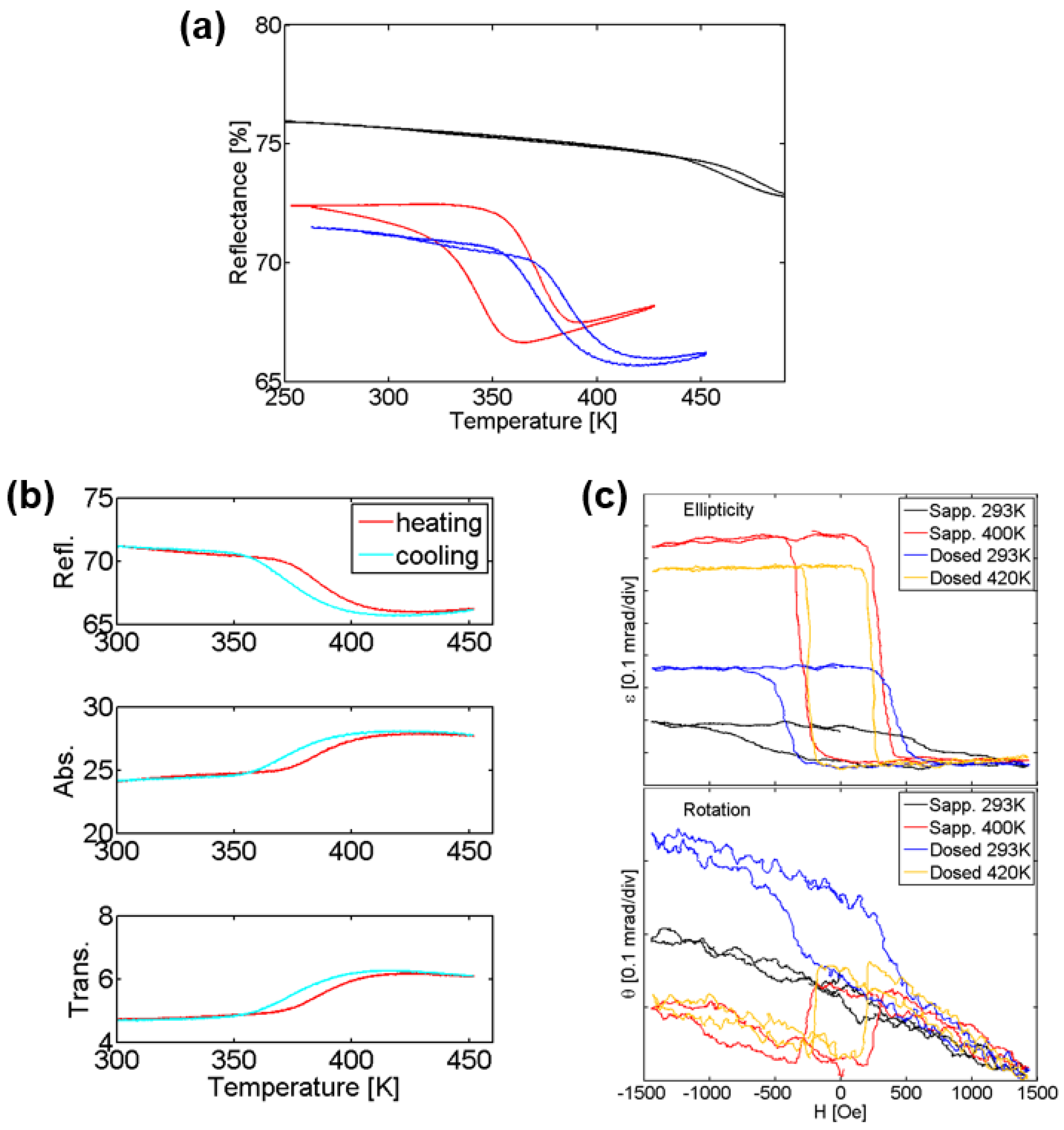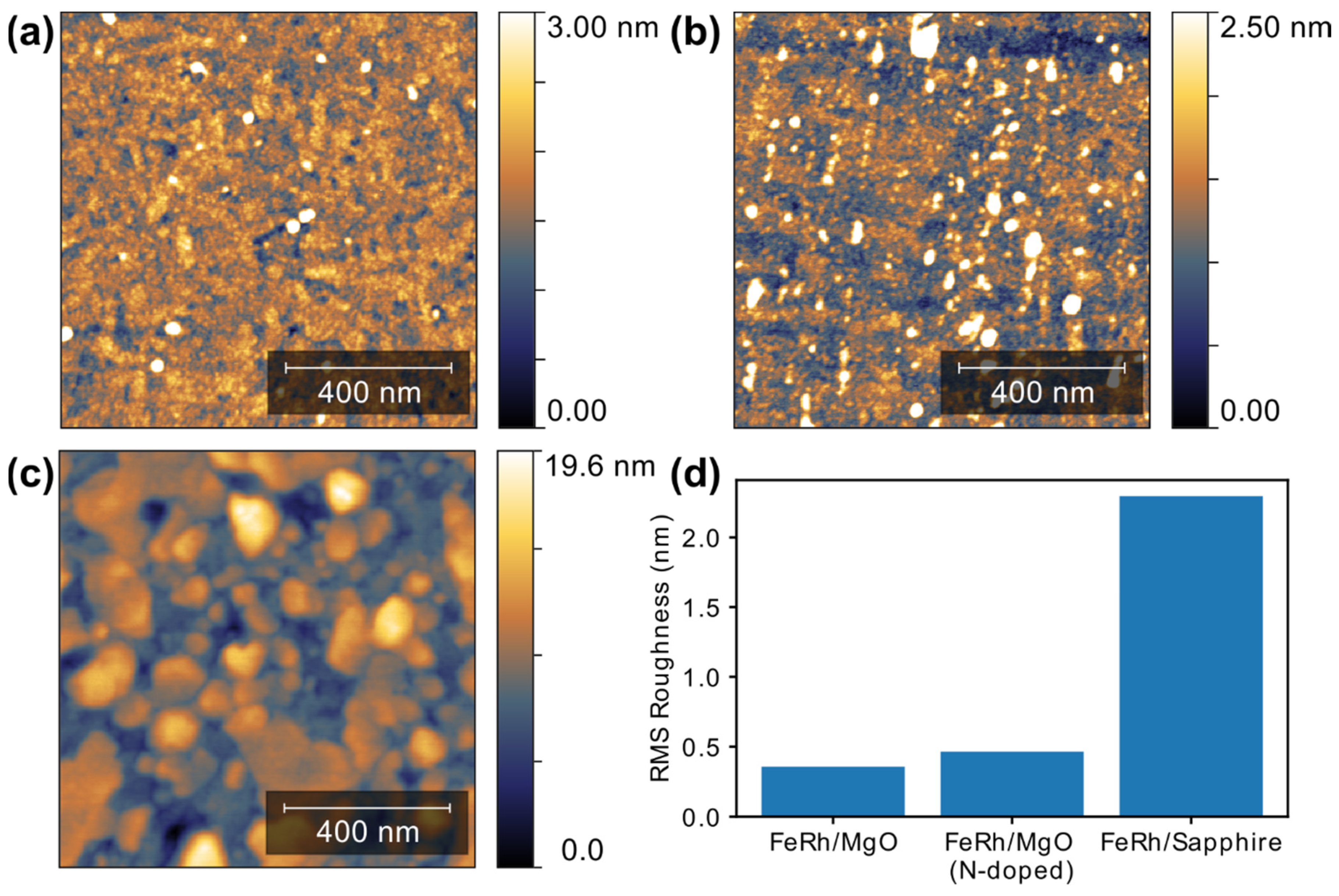N+ Irradiation and Substrate-Induced Variability in the Metamagnetic Phase Transition of FeRh Films
Abstract
1. Introduction
2. Experiment
3. Conclusions
Author Contributions
Funding
Institutional Review Board Statement
Informed Consent Statement
Acknowledgments
Conflicts of Interest
References
- Masanet, E.; Shehabi, A.; Lei, N.; Smith, S.; Koomey, J. Recalibrating global data center energy-use estimates: Growth in energy use has slowed owing to efficiency gains that smart policies can help maintain in the near term. Science 2020, 367, 984–986. [Google Scholar] [CrossRef]
- Jones, N. How to stop data centres from gobbling up the world’s electricity. Nature 2018, 561, 163–166. [Google Scholar] [CrossRef]
- Bae, S.H.; Lee, S.; Koo, H.; Lin, L.; Jo, B.H.; Park, C.; Wang, Z.L. The memristive properties of a single VO2 nanowire with switching controlled by self-heating. Adv. Mater. 2013, 25, 5098–5103. [Google Scholar] [CrossRef]
- Weiher, M.; Herzig, M.; Tetzlaff, R.; Ascoli, A.; Mikolajick, T.; Slesazeck, S. Improved Vertex Coloring with NbOx Memristor-Based Oscillatory Networks. IEEE Trans. Circuits Syst. I Regul. Pap. 2021, 68, 2082–2095. [Google Scholar] [CrossRef]
- Yao, P.; Wu, H.; Gao, B.; Tang, J.; Zhang, Q.; Zhang, W.; Yang, J.J.; Qian, H. Fully hardware-implemented memristor convolutional neural network. Nature 2020, 577, 641–645. [Google Scholar] [CrossRef]
- Zimmers, A.; Aigouy, L.; Mortier, M.; Sharoni, A.; Wang, S.; West, K.G.; Ramirez, J.G.; Schuller, I.K. Role of thermal heating on the voltage induced insulator-metal transition in VO2. Phys. Rev. Lett. 2013, 110, 056601. [Google Scholar] [CrossRef] [PubMed]
- Mariette, C.; Lorenc, M.; Cailleau, H.; Collet, E.; Guérin, L.; Volte, A.; Trzop, E.; Bertoni, R.; Dong, X.; Lépine, B.; et al. Strain wave pathway to semiconductor-to-metal transition revealed by time-resolved X-ray powder diffraction. Nat. Commun. 2021, 12, 1239. [Google Scholar] [CrossRef]
- Sakai, J.; Zaghrioui, M.; Matsushima, M.; Funakubo, H.; Okimura, K. Impact of thermal expansion of substrates on phase transition temperature of VO2 films. J. Appl. Phys. 2014, 116, 123510. [Google Scholar] [CrossRef]
- Di Martino, G.; Demetriadou, A.; Li, W.; Kos, D.; Zhu, B.; Wang, X.; de Nijs, B.; Wang, H.; MacManus-Driscoll, J.; Baumberg, J.J. Real-time in situ optical tracking of oxygen vacancy migration in memristors. Nat. Electron. 2020, 3, 687–693. [Google Scholar] [CrossRef]
- Kouvel, J.S.; Hartelius, C.C. Anomalous magnetic moments and transformations in the ordered alloy FeRh. J. Appl. Phys. 1962, 33, 1343–1344. [Google Scholar] [CrossRef]
- Lommel, J.M. Magnetic and electrical properties of FeRh thin films. J. Appl. Phys. 1966, 37, 1483–1484. [Google Scholar] [CrossRef]
- Lommel, J.M.; Kouvel, J.S. Effects of mechanical and thermal treatment on the structure and magnetic transitions in FeRh. J. Appl. Phys. 1967, 38, 1263–1264. [Google Scholar] [CrossRef]
- Han, G.C.; Qiu, J.J.; Yap, Q.J.; Luo, P.; Laughlin, D.E.; Zhu, J.G.; Kanbe, T.; Shige, T. Magnetic stability of ultrathin FeRh films. J. Appl. Phys. 2013, 113, 17C107. [Google Scholar] [CrossRef]
- Keavney, D.J.; Choi, Y.; Holt, M.V.; Uhlíř, V.; Arena, D.; Fullerton, E.E.; Ryan, P.J.; Kim, J.W. Phase coexistence and kinetic arrest in the magnetostructural transition of the ordered alloy FeRh. Sci. Rep. 2018, 8, 1778. [Google Scholar] [CrossRef] [PubMed]
- Fan, R.; Kinane, C.J.; Charlton, T.R.; Dorner, R.; Ali, M.; De Vries, M.A.; Brydson, R.M.D.; Marrows, C.H.; Hickey, B.J.; Arena, D.A.; et al. Ferromagnetism at the interfaces of antiferromagnetic FeRh epilayers. Phys. Rev. B Condens. Matter Mater. Phys. 2010, 82, 184418. [Google Scholar] [CrossRef]
- Jungwirth, T.; Marti, X.; Wadley, P.; Wunderlich, J. Antiferromagnetic spintronics. Nat. Nanotechnol. 2016, 11, 231–241. [Google Scholar] [CrossRef]
- Němec, P.; Fiebig, M.; Kampfrath, T.; Kimel, A.V. Antiferromagnetic opto-spintronics. Nat. Phys. 2018, 14, 229–241. [Google Scholar] [CrossRef]
- Baltz, V.; Manchon, A.; Tsoi, M.; Moriyama, T.; Ono, T.; Tserkovnyak, Y. Antiferromagnetic spintronics. Rev. Mod. Phys. 2018, 90, 015005. [Google Scholar] [CrossRef]
- Barton, C.W.; Ostler, T.A.; Huskisson, D.; Kinane, C.J.; Haigh, S.J.; Hrkac, G.; Thomson, T. Substrate Induced Strain Field in FeRh Epilayers Grown on Single Crystal MgO (001) Substrates. Sci. Rep. 2017, 7, 44397. [Google Scholar] [CrossRef] [PubMed]
- Barua, R.; Jiménez-Villacorta, F.; Lewis, L.H. Predicting magnetostructural trends in FeRh-based ternary systems. Appl. Phys. Lett. 2013, 103, 102407. [Google Scholar] [CrossRef]
- Bennett, S.P.; Ambaye, H.; Lee, H.; LeClair, P.; Mankey, G.J.; Lauter, V. Direct Evidence of Anomalous Interfacial Magnetization in Metamagnetic Pd doped FeRh Thin Films. Sci. Rep. 2015, 5, 9142. [Google Scholar] [CrossRef]
- Urban, C.; Bennett, S.P.; Schuller, I.K. Hydrostatic pressure mapping of barium titanate phase transitions with quenched FeRh. Sci. Rep. 2020, 10, 6312. [Google Scholar] [CrossRef]
- Cress, C.D.; Wickramaratne, D.; Rosenberger, M.R.; Hennighausen, Z.; Callahan, P.G.; LaGasse, S.W.; Bernstein, N.; van’t Erve, O.M.; Jonker, B.T.; Qadri, S.B.; et al. Direct-Write of Nanoscale Domains with Tunable Metamagnetic Order in FeRh Thin Films. ACS Appl. Mater. Interfaces 2021, 13, 836–847. [Google Scholar] [CrossRef]
- Bennett, S.P.; Herklotz, A.; Cress, C.D.; Ievlev, A.; Rouleau, C.M.; Mazin, I.I.; Lauter, V. Magnetic order multilayering in FeRh thin films by the He-ion irradiation. Mater. Res. Lett. 2018, 6, 106–112. [Google Scholar] [CrossRef]
- Heidarian, A.; Bali, R.; Grenzer, J.; Wilhelm, R.A.; Heller, R.; Yildirim, O.; Lindner, J.; Potzger, K. Tuning the antiferromagnetic to ferromagnetic phase transition in FeRh thin films by means of low-energy/low fluence ion irradiation. Nucl. Instrum. Methods Phys. Res. Sect. B Beam Interact. Mater. Atoms 2015, 358, 251–254. [Google Scholar] [CrossRef]
- Uhlíř, V.; Arregi, J.A.; Fullerton, E.E. Colossal magnetic phase transition asymmetry in mesoscale FeRh stripes. Nat. Commun. 2016, 7, 13113. [Google Scholar] [CrossRef]
- Ostler, T.A.; Barton, C.; Thomson, T.; Hrkac, G. Modeling the thickness dependence of the magnetic phase transition temperature in thin FeRh films. Phys. Rev. B 2017, 95, 064415. [Google Scholar] [CrossRef]
- Cherifi, R.O.; Ivanovskaya, V.; Phillips, L.C.; Zobelli, A.; Infante, I.C.; Jacquet, E.; Garcia, V.; Fusil, S.; Briddon, P.R.; Guiblin, N.; et al. Electric-field control of magnetic order above room temperature. Nat. Mater. 2014, 13, 345–351. [Google Scholar] [CrossRef]
- Bennett, S.P.; Wong, A.T.; Glavic, A.; Herklotz, A.; Urban, C.; Valmianski, I.; Biegalski, M.D.; Christen, H.M.; Ward, T.Z.; Lauter, V. Giant Controllable Magnetization Changes Induced by Structural Phase Transitions in a Metamagnetic Artificial Multiferroic. Sci. Rep. 2016, 6, 22708. [Google Scholar] [CrossRef] [PubMed]
- Zolotoyabko, E. Determination of the degree of preferred orientation within the March-Dollase approach. J. Appl. Crystallogr. 2009, 42, 513–518. [Google Scholar] [CrossRef]
- Dollase, W.A. Correction of intensities of preferred orientation in powder diffractometry: Application of the march model. J. Appl. Crystallogr. 1986, 19, 267–272. [Google Scholar] [CrossRef]
- Bennett, S.P.; Currie, M.; van’t Erve, O.M.J.; Mazin, I.I. Spectral reflectivity crossover at the metamagnetic transition in FeRh thin films. Opt. Mater. Express 2019, 7, 2870. [Google Scholar] [CrossRef]
- Gray, I.; Stiehl, G.M.; Heron, J.T.; Mei, A.B.; Schlom, D.G.; Ramesh, R.; Ralph, D.C.; Fuchs, G.D. Imaging uncompensated moments and exchange-biased emergent ferromagnetism in FeRh thin films. Phys. Rev. Mater. 2019, 3, 124407. [Google Scholar] [CrossRef]




Publisher’s Note: MDPI stays neutral with regard to jurisdictional claims in published maps and institutional affiliations. |
© 2021 by the authors. Licensee MDPI, Basel, Switzerland. This article is an open access article distributed under the terms and conditions of the Creative Commons Attribution (CC BY) license (https://creativecommons.org/licenses/by/4.0/).
Share and Cite
Bennett, S.P.; LaGasse, S.W.; Currie, M.; Erve, O.V.; Prestigiacomo, J.C.; Cress, C.D.; Qadri, S.B. N+ Irradiation and Substrate-Induced Variability in the Metamagnetic Phase Transition of FeRh Films. Coatings 2021, 11, 661. https://doi.org/10.3390/coatings11060661
Bennett SP, LaGasse SW, Currie M, Erve OV, Prestigiacomo JC, Cress CD, Qadri SB. N+ Irradiation and Substrate-Induced Variability in the Metamagnetic Phase Transition of FeRh Films. Coatings. 2021; 11(6):661. https://doi.org/10.3390/coatings11060661
Chicago/Turabian StyleBennett, Steven P., Samuel W. LaGasse, Marc Currie, Olaf Van’t Erve, Joseph C. Prestigiacomo, Cory D. Cress, and Syed B. Qadri. 2021. "N+ Irradiation and Substrate-Induced Variability in the Metamagnetic Phase Transition of FeRh Films" Coatings 11, no. 6: 661. https://doi.org/10.3390/coatings11060661
APA StyleBennett, S. P., LaGasse, S. W., Currie, M., Erve, O. V., Prestigiacomo, J. C., Cress, C. D., & Qadri, S. B. (2021). N+ Irradiation and Substrate-Induced Variability in the Metamagnetic Phase Transition of FeRh Films. Coatings, 11(6), 661. https://doi.org/10.3390/coatings11060661






